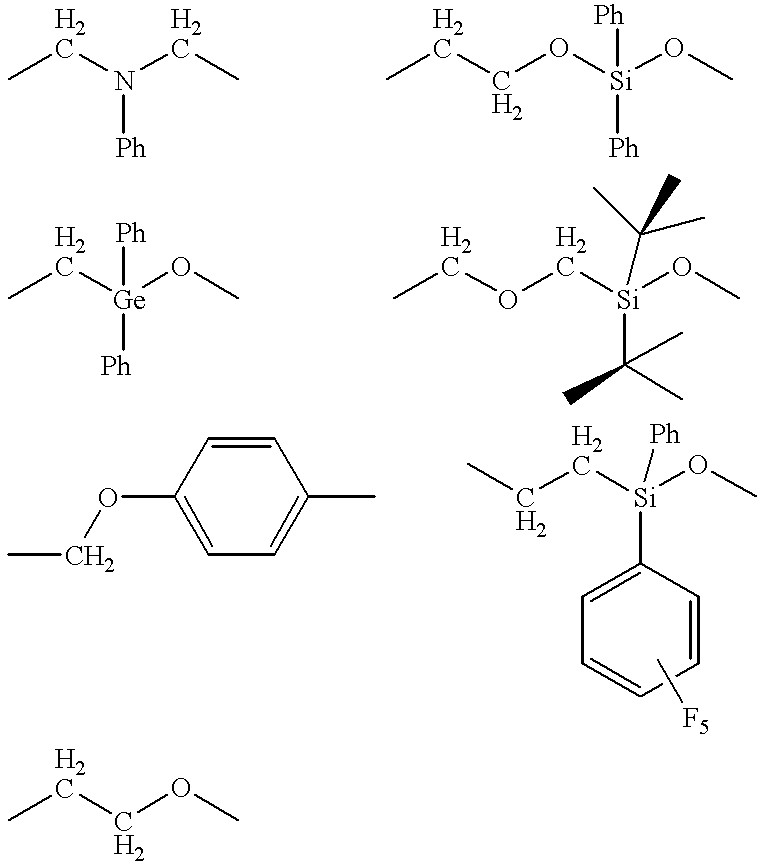Polymeric supported catalysts for olefin polymerization
a technology of polymerization and catalysts, applied in the field of olefin polymerization, can solve the problems of low reaction product yield and undesirable byproducts, decrease in the control of polymerization, and fouling of reactor walls or piping, and achieve the effect of low fouling and high particle density
- Summary
- Abstract
- Description
- Claims
- Application Information
AI Technical Summary
Benefits of technology
Problems solved by technology
Method used
Image
Examples
example 1
Preparation of Ionic Activator Bead Composition
Unfunctionalized polystyrene beads (S-X1 from Biorad Laboratories, 10.03 g) were stirred in dry air free cyclohexane (120 mL) under Ar. Tetramethylethylenediamine (TMEDA, 10.4 mL=66 mmol) was added and then the reaction mixture was heated to 60.degree. C. A 2.6 M solution of n-butyllithium in hexane (35 mL=91 mmol) was added by syringe causing a rapid darkening of the suspension. After four hours stirring, the reaction mixture was cooled and filtered, yielding red / brownbeads. These were washed with freshly distilled dioxane until no more color was extracted (5.times.100 mL). They were then treated with a solution of B(C.sub.6 F.sub.5).sub.3 (13.188 g=25.8 mmol) in dioxane (100 mL), leading to rapid loss of the dark red color, and left to stir in this solution overnight. The pale brown beads were then filtered, washed twice with dioxane, and once with dioxane / water 80 / 20. They were then extracted with dioxane / water and then THF in a soxh...
example 2
Catalyst A Preparation
In an inert atmosphere glove box, 1.01 grams of the Ionic Activator Beads from Example 1 with 0.34 mmol available functional group per gram of beads (i.e., 0.34 meq) were added to a toluene solution (60 mL) of dimethylsilylbis(h.sup.5 -2-methylindenyl) zirconium dimethyl (0.425 g, 0.975 mmol, 2.8 eq) at 25.degree. C. under nitrogen with vigorous stirring. The reaction was stirred for 1 h, and then the supported activator was isolated by vacuum filtration and washed with four 15 mL portions of dry, oxygen free toluene. The supported catalyst was then dried overnight in vacuo, yielding 0.958 g of finished catalyst (some material loss due to transfer), with a calculated loading of 0.30 mmol of active transition metal per gram of finished catalyst.
example 3
Catalyst B Preparation
Catalyst B was prepared in analogous manner to Catalyst A, but 0.815 grams of the Ionic Activator Beads from Example 1 with 0.34 mmol available functional group per gram of beads (i.e., 0.34 meq) was reacted with cyclopentadienyl(pentamethylcyclopentadienyl) zirconium dimethyl (0.132 g, 0.412 mmol, 1.5 eq), yielding 0.792 g of finished catalyst (some material loss due to transfer), with a calculated loading of 0.31 mmol of active transition metal per gram of finished catalyst.
PUM
| Property | Measurement | Unit |
|---|---|---|
| Length | aaaaa | aaaaa |
| Composition | aaaaa | aaaaa |
| Density | aaaaa | aaaaa |
Abstract
Description
Claims
Application Information
 Login to View More
Login to View More - R&D
- Intellectual Property
- Life Sciences
- Materials
- Tech Scout
- Unparalleled Data Quality
- Higher Quality Content
- 60% Fewer Hallucinations
Browse by: Latest US Patents, China's latest patents, Technical Efficacy Thesaurus, Application Domain, Technology Topic, Popular Technical Reports.
© 2025 PatSnap. All rights reserved.Legal|Privacy policy|Modern Slavery Act Transparency Statement|Sitemap|About US| Contact US: help@patsnap.com

